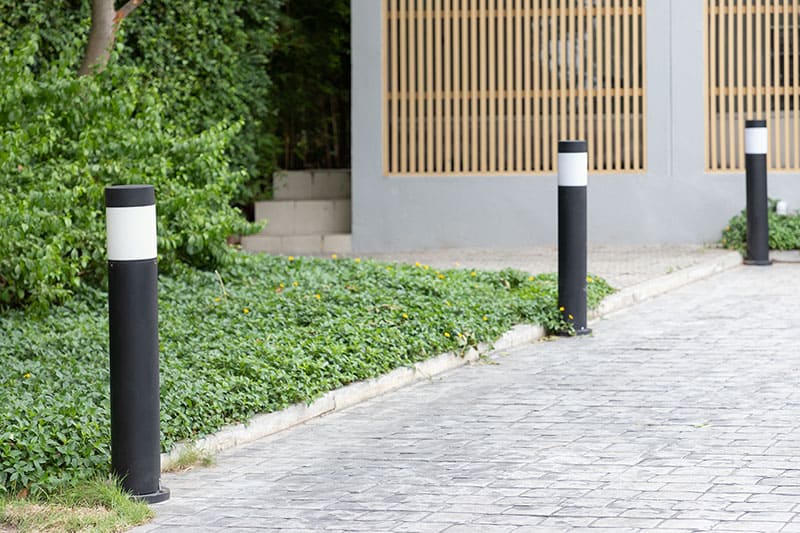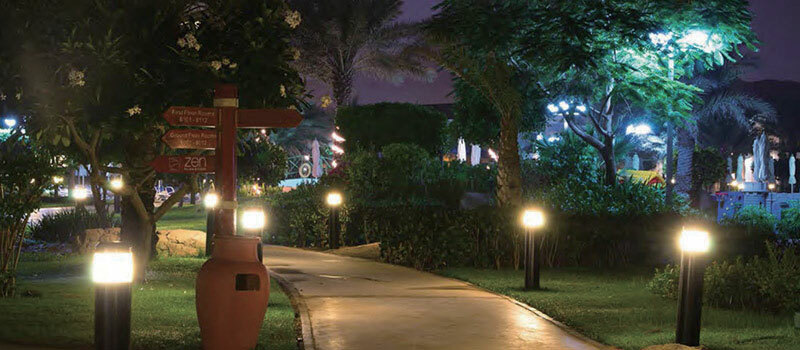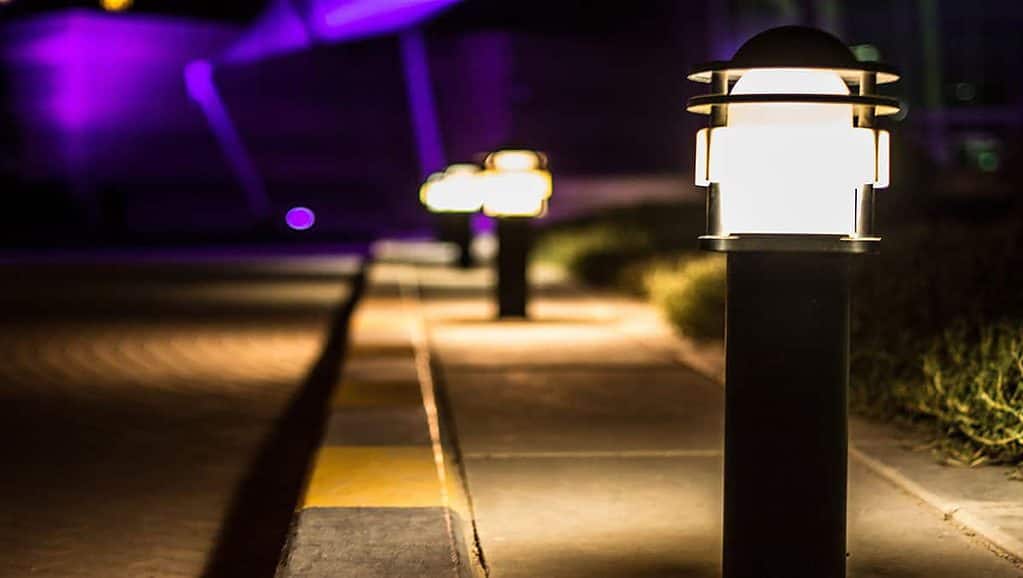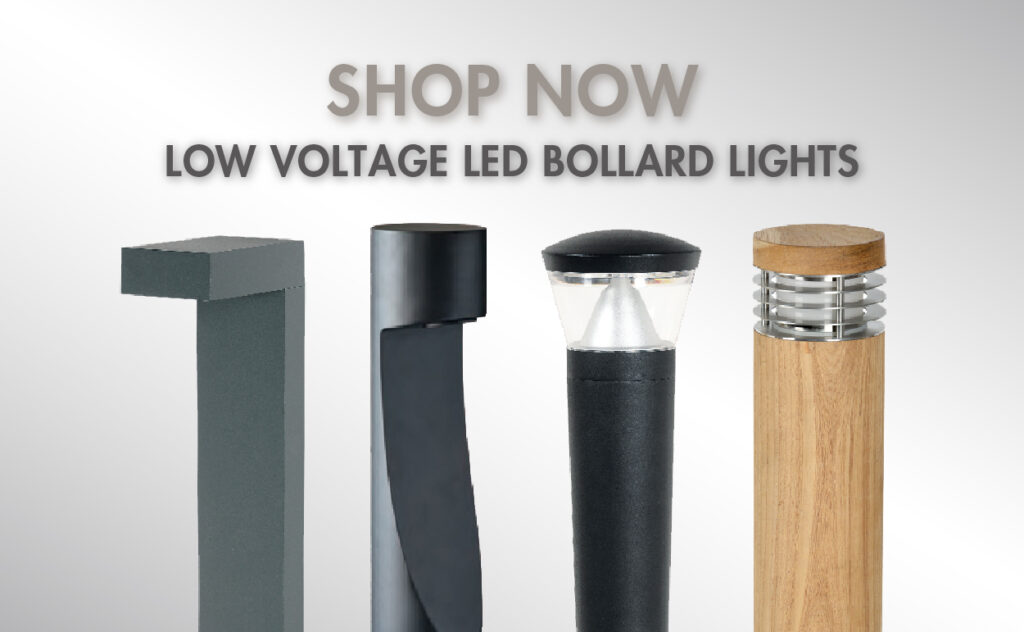What are Bollard Lights?
Bollard lights are advanced outdoor lighting sources that are mounted on vertical posts. This unique style of outdoor illumination features a lighting fixture mounted on a vertical post of a minimum height of around 1 foot.
Bollard lights are suitable for sports lighting, parking lots, small car parks, residential pathways, etc. Bollard light fixtures, however, can contribute to light pollution if they are not adequately spaced and shielded. The institution should direct light only where it is required by adjusting the angle of the beam and adding shielding.
Dark-sky-compliant bollard lights usually have the ideal shielding and can effectively and efficiently create light space.

Bollard Spacing
The spacing or placement of bollard lights depends on several factors, including personal preference, bollard optics, ambient light levels, and site requirements. Lighting requirements typically vary depending on the application of the bollard lights.
How Do Bollard Optics Affect Bollard Light Spacing
When designing a bollard lighting exterior, you must select the right optics for the proper layout.
This will allow you to optimize bollard spacing and minimize spill light. You are correcting the spacing and avoiding spilling too much light.
Here are three popular bollard optics and how they affect spacing:
Standard Reflector
A popular choice for illuminating walkways and driveways for safety is standard reflectors. They hide the light source and deliver even downward light distribution.
For example, aluminum cone reflector LED bollards deliberately direct the light down to illuminate pathways.
When dealing with standard aluminum cone reflector lights, you can maintain a 0.5 footcandle between two fixtures with 14 feet or less spacing.

Type V Glass
Type V glass is the next popular choice of bollard lights for walkways and driveways. Bollard light fixtures with this technology diffuse the beam while providing broad light distribution.
The LED array is usually installed beneath the top of the fixture. The colorful, clear type V glass provides low glare. If light trespass is an issue, you can use an optional light shield to prevent the light from going where you don’t want it to.
The ideal spacing requirement between two type V bollard lights to maintain a 0.5 footcandle is 9 feet or less.
Louvered LED Bollard Light Fixtures
Louvers have a classic look and incredible aesthetic value. These stylish LED lights suit lighting applications that need minimum light pollution.
Architectural grade round LED lights with louvers are perfect for commercial and pedestrian use. They provide not only excellent light distribution but also safety and visual comfort.
You can effectively maintain a 0.5 footcandle between two louvered fixtures with 7 feet or less spacing.
Comparison Using a 15-Watt LED Array
A type V bollard light will distribute 1 footcandle over a 12-foot diameter. A louvered fixture will spread 1 foot-candle over a 4.5-foot diameter. A standard reflector bollard light will distribute 1 footcandle over a 7.5-foot diameter.
According to these figures from an access fixtures lighting specialist, you can maintain 1 footcandle with type V bollards by spacing 24 feet. The light distribution will feature dark spots if you place the bollards apart.
How Mounting Height Affects Spacing
Bollard lights are available in three main sizes, large, medium, and trim. Large LED bollard lights range in height from 39 to 47 inches, medium lamps range from 25 to 38 inches, and small ones range from 8 to 24 inches.
The ideal spacing between LED or HID bollard lights depends on the minimum light level. The darkest space between bollards must not be below the lowest illuminance level.
Bollard lights with a high mounting height of approximately 39 to 47 inches can push more light toward the sides. But will have a low illuminance level at the front. This means you can have wider spacing between taller bollards.
A bollard light with a lower mounting height produces less light towards the sides and bright light at the front. This, therefore, requires you to mount small LED bollard lights closer to each other to provide the appropriate light levels.

How Light Directions Affect Spacing
The bollard light direction does also affect spacing. There would be three main types of bollard lights if you considered advice of lighting – shielded, wide beam, and unshielded.
Shielded Bollard Lights
The reflectors on shielded fixtures direct the light to the ground. The light is contained in the front of the luminaire, with no side lighting. Shielded luminaires provide maximum glare control, appropriate light output, and superior visual comfort.
The spacing of these bollard lights has to be closer to produce functional light along the pathway.
Wide Beam Bollard Lights
These types of bollard lamps have wide light distribution. These lights are not as bright in the front as shielded lamps. But they produce a much wider illuminated area towards the sides. These fixtures are typically spaced far apart while maintaining minimum illuminance levels.
Unshielded Bollard Lights
As the name suggests, these bollard lamps don’t have any shielding. They are specifically designed to provide ambient light output. They are the perfect choice for vertical lighting, especially for facial recognition and landscape elements.
Access Fixtures Bollard Light Spacing
Access Fixtures is well-known for its production of high-performance outdoor lighting solutions. Here is a breakdown of the recommended spacing for some of their popular fixtures:
ARIE
This is a round-open-top luminaire that features a polycarbonate lens. The light is approximately 42 inches high and has a 19-watt rating. It is suitable for industrial parks, retail centers, and campuses. The ARIE light has a 16-foot illumination diameter or a lighting distribution of 8 feet away.
CLYD
The CLYD bollard light has a power rating of 19 watts. It comes with a round-flat-top design that is dark sky friendly. The light is roughly 34 inches high. It distributes 1 footcandle of light in a 12-foot diameter or 6 feet away.
CONA
The CONA LED bollard has a cone reflector and a round-flat-top design. It features 17 system watts that produce up to 1,510 lumens. It distributes 1 footcandle of light in 12-foot diameter and up to 6 feet away.
LUVO
This LED bollard light has a medium socket louvered round-flat-top design. It has a power rating of 17 system watts and is approximately 42 inches tall. Its design can distribute 1 footcandle of light up to 4 feet away. It reflects light to the ground, which is ideal for car parks and pedestrian use.

How to Install Bollard Lights
Once you have determined the appropriate spacing requirements for your outdoor bollard lights, you can proceed with the installation process.
Any installation of LED bollard lights must comply with the local building codes. So, you may have to employ the services of a professional like an access fixtures lighting specialist.
But, understanding the installation process of bollard lighting luminaires can help you make an informed decision about bollard light spacing and purchase.
Here is our step-by-step breakdown:
Step 1: Dig a Deep Hole
You have to check with your local building codes for the correct depth. The hole must be deep enough to hold the cement and fixture firmly.
Step 2: Place a Tube and Run the Appropriate Wiring
Mount a tube into the hole, ensuring that the top of the tube is above the surface. Use rocks to stabilize the tube and keep it in an upright position.
It is essential to run the appropriate wiring for the installation for safe burial and longevity. It would help if you had enough length for a stress-free connection to the socket or ballast.
Run the wire through the center of the tube and set up the anchor bolts. Then fill the tube with vast quantities of cement and sink the anchor bolts into the wet cement.
Step 3: Mount the Plate and Wire the Socket
Insert the mounting plate into the bolts and bolt it down. Then wire the LED driver, ballast, or socket to the wiring. Mount the bollard lights, connect the wiring to a power source and turn on the light.
Conclusion
Bollard lighting is one of the best outdoor lighting technologies. But to make the most out of it, you must correct the spacing or placement of bollard lights.
This guide has covered all the critical factors that affect bollard light spacing and site planning. In addition to this guide, we recommend consulting a bollard lighting specialist for further assistance.
RC Lighting is one of the leading outdoor lighting manufacturers in China. Contact us if you have questions about bollard lights or other outdoor lighting fixtures.



